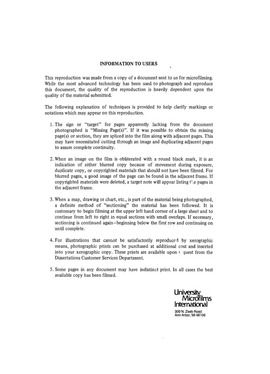| dc.contributor.author | Badkoobehi, Hassan, | en_US |
| dc.date.accessioned | 2013-08-16T12:28:50Z | |
| dc.date.available | 2013-08-16T12:28:50Z | |
| dc.date.issued | 1982 | en_US |
| dc.identifier.uri | https://hdl.handle.net/11244/5083 | |
| dc.description.abstract | Oklahoma is presently experiencing population growth as well as industrial and agricultural expansion. This state is fortunate to have potentially sufficient water resources (not excess) within its boundaries to supply all of its anticipated needs. The problems one of management, because most of the state's water resources are located in Eastern Oklahoma, while Western Oklahoma suffers from a lack of water sources. Central Oklahoma is the median of the two areas, experiencing periods of both drought and abundance. There has been extensive water resource development in the state, but the need for blending this work into a totally coordinated statewide effort is apparent if optimum benefits are to be realized from the state's resources. Thus a generalized plan is needed to evaluate the safe yield from ground water and through storage from surface water in Oklahoma. | en_US |
| dc.description.abstract | This study will employ the appropriate existing technologies, in a unique form to achieve a safe yield. Furthermore, it will determine and well fields should be, and approximately how much the project would where the surface and ground water is available, how large the reservoirs and well fields should be, and approximately how much the project would cost. The investigation will consist of a case study of one of the river basins to provide detailed calculations. It is appropriate to apply the results obtained from this study to all fourteen Oklahoma River Basins to evaluate storage capacity and related costs to produce selected dependable flows. | en_US |
| dc.description.abstract | Utilization of this research should be a great help to administrators, public officials, engineers, and planners such as the personnel of the Oklahoma Water Resources Board. The results obtained herein will enable them to recognize those factors that affect water uses and to plan for more feasible water resources development with a realistic basis to meet future water requirements. | en_US |
| dc.description.abstract | The theoretical basis, called the supply model, assumes that the available water resource exceeds the demand, site by site. Other models would be the resources model, wherein they are equal, or demand model, wherein the demand exceeds the supply. | en_US |
| dc.format.extent | xiii, 152 leaves : | en_US |
| dc.subject | Urban and Regional Planning. | en_US |
| dc.title | State supply side water model. | en_US |
| dc.type | Thesis | en_US |
| dc.thesis.degree | Ph.D. | en_US |
| dc.thesis.degreeDiscipline | School of Civil Engineering and Environmental Science | en_US |
| dc.note | Source: Dissertation Abstracts International, Volume: 43-11, Section: A, page: 3729. | en_US |
| ou.identifier | (UMI)AAI8306737 | en_US |
| ou.group | College of Engineering::School of Civil Engineering and Environmental Science | |
